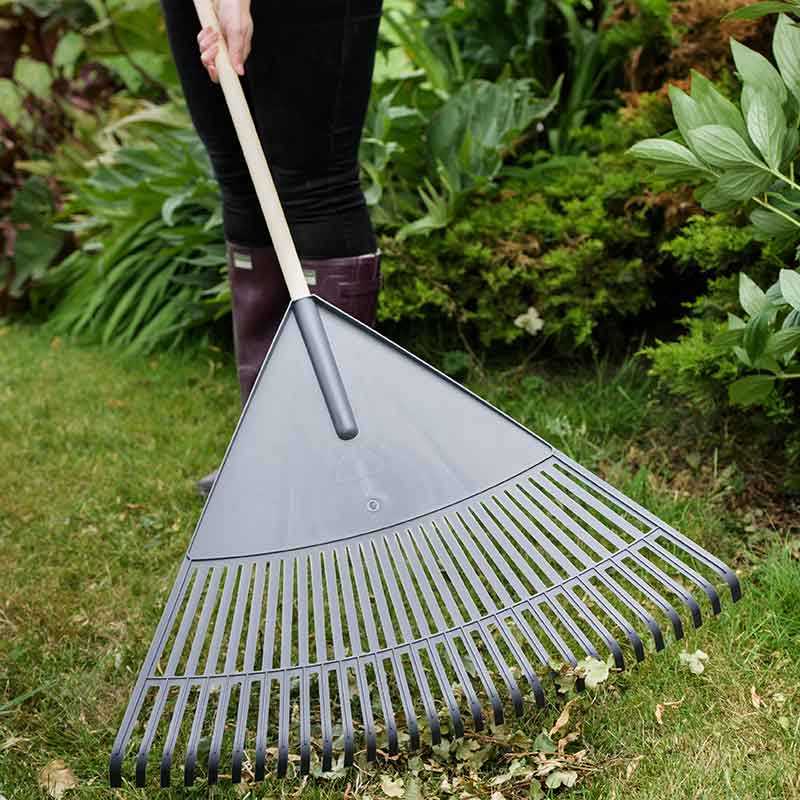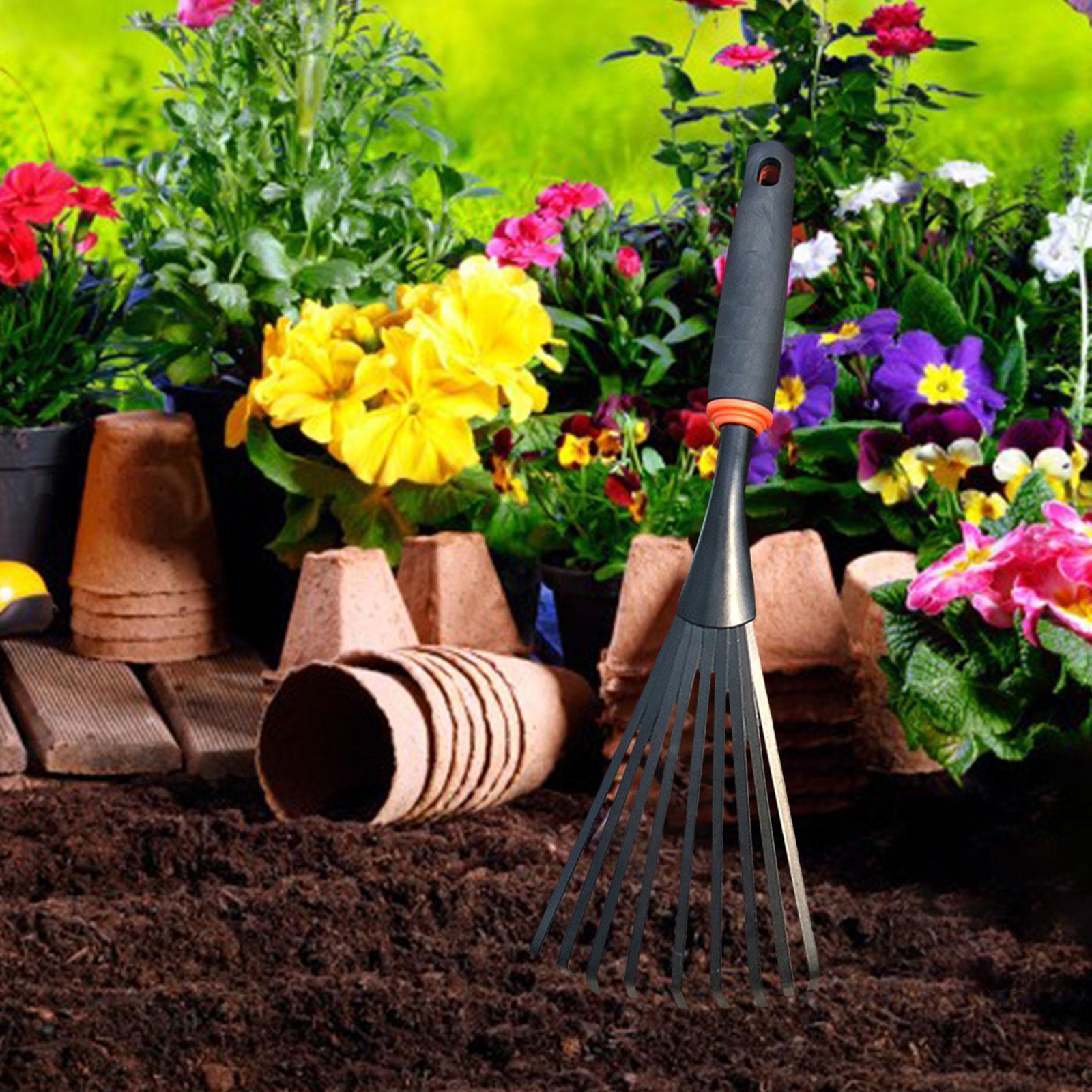
Types of Rakes: Choosing the Right Tool for Your Yard
Introduction
Rakes play a crucial role in lawn and garden maintenance. These versatile tools help keep outdoor spaces tidy and well-maintained. Understanding the different types of rakes available can make yard work more efficient and effective. This comprehensive guide explores various rake types, their uses, and how to choose the right one for specific tasks.
Leaf Rakes: The Autumn Essential
Leaf rakes, also known as lawn rakes, are designed specifically for gathering fallen leaves and light debris. Their wide, fan-shaped heads consist of flexible tines that gently sweep across grass without damaging the turf. Most leaf rakes feature plastic or metal tines attached to a long wooden or metal handle. The tines spread out in a triangular shape, creating a large surface area for efficient leaf collection.
Lightweight and easy to maneuver, leaf rakes come in various sizes to suit different yard sizes and user preferences. Some models feature adjustable heads, allowing users to customize the rake’s width for different areas of the yard. Leaf rakes work best on dry leaves and grass clippings, making them ideal for autumn clean-up tasks. Regular use of a leaf rake helps prevent thatch buildup and promotes a healthier lawn. When selecting a leaf rake, consider factors such as the rake’s weight, handle length, and tine material to ensure comfortable and effective use.
Garden Rakes: The Multi-Purpose Workhorse
Garden rakes, also called bow rakes or level head rakes, feature a straight metal head with short, sturdy tines. These versatile tools serve multiple purposes in gardening and landscaping. The rigid tines of a garden rake effectively break up soil clumps, level surfaces, and spread mulch or gravel. Gardeners use these rakes to prepare seedbeds, remove rocks and debris from soil, and create furrows for planting. The flat top of the rake head can smooth out soil or sand, making it useful for grading and contouring landscapes.
Garden rakes typically have steel or aluminum heads attached to wooden or fiberglass handles. The tines on garden rakes are usually spaced closer together than those on leaf rakes, allowing for more precise soil manipulation. When choosing a garden rake, consider the head width and material, as well as the handle length and grip comfort. Heavier-duty garden rakes with forged steel heads offer durability for tough jobs, while lighter aluminum models provide easier maneuverability for general gardening tasks.
Thatch Rakes: Reviving Your Lawn
Thatch rakes, specialized tools for lawn maintenance, help remove the layer of dead grass, roots, and debris that accumulates between the soil surface and living grass blades. This layer, known as thatch, can prevent water, air, and nutrients from reaching grass roots when it becomes too thick. Thatch rakes feature sharp, curved tines designed to penetrate the turf and pull up the thatch layer. These rakes typically have a double-sided head, with one side for dethatching and the other for removing the loosened thatch.
The tines on a thatch rake are usually made of durable steel to withstand the rigors of dethatching. Some models feature adjustable tine settings to accommodate different grass types and thatch thicknesses. Using a thatch rake requires more effort than standard raking, but it significantly improves lawn health by promoting better air and water circulation. For larger lawns, power dethatchers or vertical mowers may be more efficient alternatives to manual thatch rakes. When selecting a thatch rake, consider the rake’s weight, handle length, and tine spacing to ensure effective and comfortable use.
Shrub Rakes: Precision for Tight Spaces
Shrub rakes, also known as hand rakes or shrub rakes, are smaller versions of leaf rakes designed for use in confined areas. These compact tools feature narrow heads with short handles, making them ideal for raking leaves and debris from flower beds, under shrubs, and between plants. The reduced size of shrub rakes allows for greater maneuverability in tight spaces where full-sized rakes cannot reach. Most shrub rakes have metal tines, which provide durability and the ability to handle slightly heavier debris than plastic tines.
The tines are typically arranged in a fan shape, similar to leaf rakes, but with a much narrower spread. Some models feature adjustable heads that can be angled for even greater versatility in confined spaces. Gardeners find shrub rakes particularly useful for maintaining rock gardens, raised beds, and container plantings. When choosing a shrub rake, consider the overall length, head width, and tine material to ensure it meets specific gardening needs. Look for models with comfortable grips and lightweight construction to reduce hand fatigue during extended use.
Landscape Rakes: Tackling Large-Scale Projects
Landscape rakes, also called lawn leveling rakes or grading rakes, are heavy-duty tools designed for large-scale landscaping projects. These rakes feature wide, flat heads with sturdy metal tines, often spanning 24 to 36 inches or more. The long, straight tines of landscape rakes make them effective for grading and leveling large areas of soil, sand, or gravel. Landscapers and contractors use these rakes to prepare surfaces for sod installation, create proper drainage slopes, and spread materials evenly across large areas.
The wide head of a landscape rake allows for efficient coverage of expansive spaces, making quick work of tasks that would be time-consuming with smaller rakes. Most landscape rakes have durable aluminum or steel heads attached to long, sturdy handles for increased leverage. Some models feature reversible heads, with teeth on one side for raking and a smooth edge on the other for leveling. When selecting a landscape rake, consider the head width, material strength, and handle length to ensure it can handle the intended projects. For commercial use or frequent large-scale work, look for heavy-duty models with reinforced construction and replaceable tines.

Stone Rakes: Specialized Tools for Rockwork
Stone rakes, also known as rock rakes or stone forks, are specialized tools designed for working with rocks, stones, and heavy debris. These rakes feature sturdy metal tines with wide spacing, allowing smaller particles to fall through while capturing larger rocks and debris. The tines on stone rakes are typically made of hardened steel to withstand the rigors of moving heavy materials. Landscapers and stonemasons use these rakes to clear areas of rocks and stones, prepare soil for construction projects, and sift through excavated material.
The wide tine spacing also makes stone rakes useful for removing large debris from lawns or gardens without disturbing the underlying soil. Some stone rake models feature interchangeable heads with different tine configurations to suit various tasks. When choosing a stone rake, consider the tine strength, spacing, and overall durability to ensure it can handle the intended workload. Look for models with comfortable, slip-resistant handles and ergonomic designs to reduce fatigue during extended use.
Choosing the Right Rake
Selecting the appropriate rake for a specific task significantly impacts the efficiency and effectiveness of yard work. Several factors should be considered when choosing a rake:
1. Task requirements: Determine the primary purpose of the rake, whether it’s for leaf collection, soil preparation, dethatching, or large-scale grading.
2. Yard size: Consider the area that needs to be raked. Larger yards may benefit from wider rake heads, while smaller spaces might require more compact tools.
3. Material strength: Evaluate the durability needed based on the intended use. Heavy-duty tasks require sturdier materials like steel, while lighter jobs can be handled with plastic or aluminum rakes.
4. Tine design: Look at the tine shape, spacing, and flexibility. Different tine configurations suit various raking tasks and surface types.
5. Handle length and material: Choose a handle length that allows for comfortable use without straining. Consider the handle material for durability and weight.
6. User comfort: Look for ergonomic features like cushioned grips and lightweight designs to reduce fatigue during extended use.
7. Storage space: Consider available storage space when selecting rake size and design. Some rakes feature collapsible or detachable heads for easier storage.
8. Budget: Determine a budget range and look for rakes that offer the best value within that range. Higher-quality rakes may cost more initially but often provide better longevity and performance.
9. Versatility: Consider multi-purpose rakes or those with interchangeable heads if various raking tasks need to be performed.

Factors to Consider
- Brand reputation: Research reputable brands known for producing quality garden tools. Read customer reviews and expert opinions to gauge product performance and durability.
- Warranty: Check for manufacturer warranties, especially on higher-end or specialized rakes, to protect the investment.
- Maintenance requirements: Consider the ease of cleaning and maintaining the rake. Some materials and designs are easier to care for than others.
- Environmental impact: For eco-conscious consumers, look for rakes made from sustainable materials or those produced using environmentally friendly manufacturing processes.
- Weight distribution: Pay attention to how the rake’s weight is distributed. Well-balanced rakes reduce strain and improve control during use.
- Adjustability: Some rakes offer adjustable features like expandable heads or variable tine angles. These can provide added versatility for different tasks.
- Compatibility with other tools: If planning to use the rake in conjunction with other gardening equipment, ensure compatibility and ease of use together.
- Seasonal considerations: Think about the primary seasons of use. Some rakes are better suited for specific seasonal tasks, while others offer year-round utility.
- Professional vs. casual use: Determine whether the rake will be used for professional landscaping or casual home gardening, as this impacts the required durability and features.
- Soil type: Consider the predominant soil type in the area. Some rakes perform better on sandy soils, while others are more suited to clay or loamy soils.
- Accessibility: For users with mobility issues or physical limitations, look for rakes with features that enhance ease of use, such as lightweight materials or ergonomic designs.
By carefully considering these factors, gardeners and landscapers can select the most appropriate rake for their specific needs. The right rake not only makes yard work more efficient but also helps maintain a healthy and attractive outdoor space. Remember that investing in quality tools often pays off in the long run through improved performance and durability. With the wide variety of rake types available, there’s a perfect tool for every raking task and garden maintenance need.



